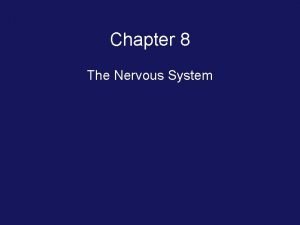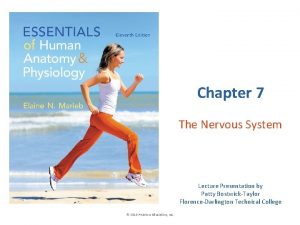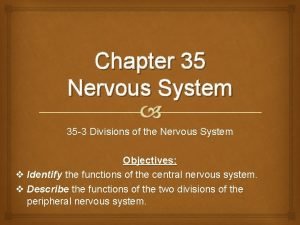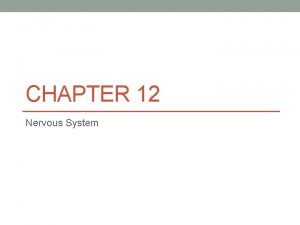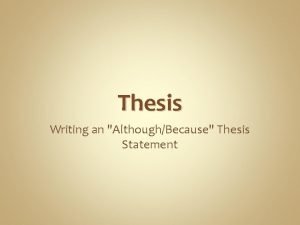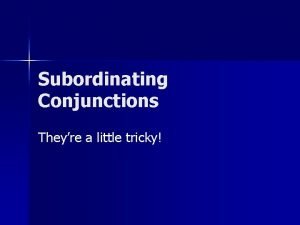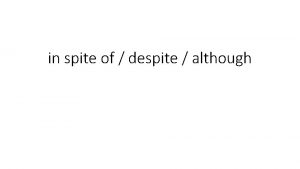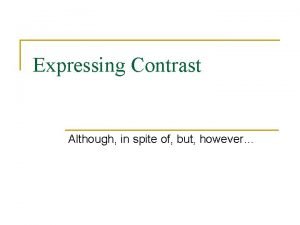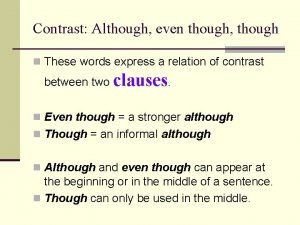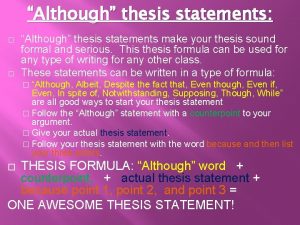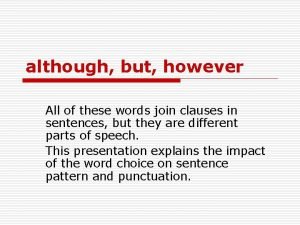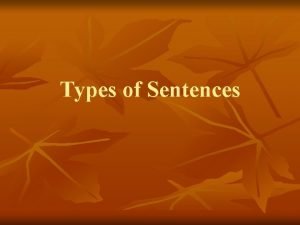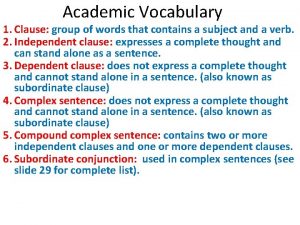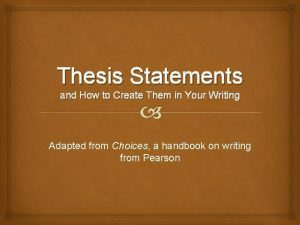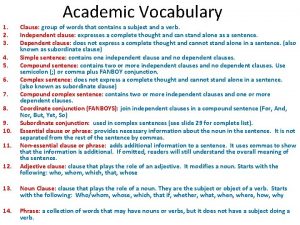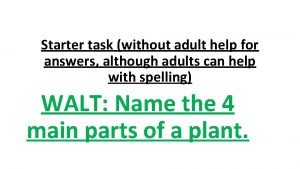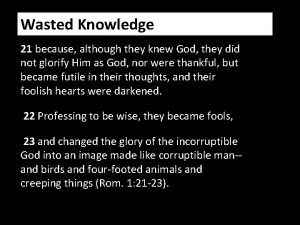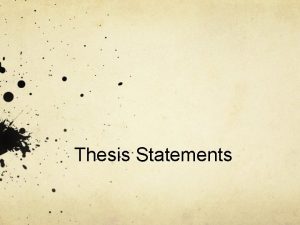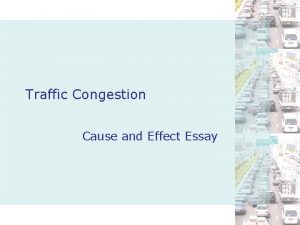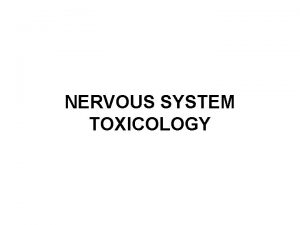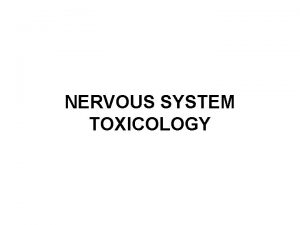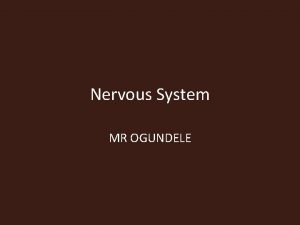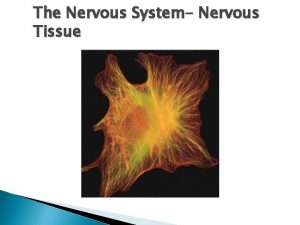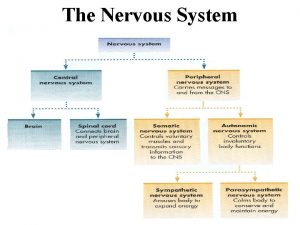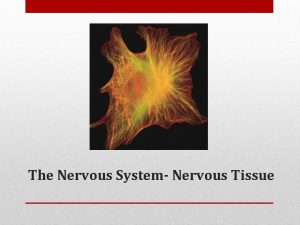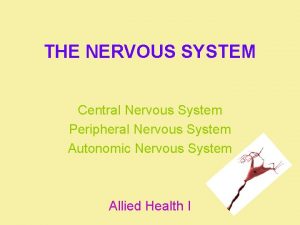The Nervous System Chapter 48 Although the Nervous





































- Slides: 37

The Nervous System Chapter 48

Although the Nervous System and the Endocrine System coordinate responses, there are 3 main differences. The nervous system: is much faster has pinpoint control has more structural complexity

Nervous system = 2 main parts: Central Nervous System (CNS) = brain & spinal cord Peripheral Nervous System (PNS) = nerves (throughout body) including: Afferent nerves: sensory Efferent nerves: motor

Efferent PNS has 2 main divisions Somatic PNS: responds to external environment (mostly voluntary) Ex. Skeletal muscle Autonomic PNS: regulate internal env (mostly involuntary) Ex. Invol. Muscle or glands

Autonomic PNS is further subdivided into: Sympathetic: stimulates organs & energy use (for action) Parasympathetic: causes energy intake and conservation – antagonistic

3 Overlapping functions of the Nervous System: sensory input: afferent neuron integration: info is interpreted and associated w/ responses by CNS motor output: efferent neuron sends signal to effector cells (muscle or gland)

Neuron Structure: Dendrites: short, highly branched fibers. Receive stimuli and send electrical impulses to cell body. Cell Body: cytoplasm, nucleus, most organelles Axon: long, branched extension of cell body – conducts nerve impulse to another neuron or effector Axon (synaptic) terminals: release neurotransmitters Synapse = gap between synaptic node and next neuron or effector


Nerve impulse: Travels in one direction ONLY! Receptor dendrite axon synapse cell body

PNS Axon Structure: Most of the axons in the PNS have 2 coverings made of supportive glia cells : Both called Schwann cells Cellular sheath: aids in nerve regeneration Myelin (inner) sheath: membrane contains myelin which provides electrical insulation Nodes of Ranvier: gaps in myelin sheath – axon not insulated (allows impulse to jump)

Multiple Sclerosis: neurological disease – deterioration of myelin sheath Causes disruptions in nerve impulse transmission, leads to – loss of coordination &/or paralysis

CNS Axon Structure: The axons in the CNS are supported and insulated by glia cells Two types: Oligodendrocytes: insulate axons (w/ myelin) Astrocytes: encircle capillaries to form a blood-brain barrier

Note: Not all neurons are exactly alike. We’re focusing on a typical PNS neuron. When a PNS neuron is wrapped in Schwann cells (like we discussed), the axons are called “white fibers. ” (“white matter” in the brain is made of glial cells & myelinated axons) If, instead, several axons are held together by a single Schwann cell that does NOT wrap around them, the axons are called “gray fibers. ” (“grey matter” in brain is cell bodies and is unmyelinated)

Nerve = Bundle of hundreds of axons wrapped together in connective tissue.

Action Potentials in Neurons Do you Remember any of this? ? ? All cells have a resting membrane potential: net difference in charge across plasma membrane Inside of cells is negatively charged due to: large neg. charged organic molecules trapped inside, Limited permeability to + ions, and the action of the Na+/K+ pump Channel Proteins (in membrane): “gates” for Na+ or K+, voltage regulated

In Neurons An electrical or chemical disturbance near the dendrite causes a local depolarization which opens the Na+ gates, in and Na+ rushes ______. The depolarization causes an opening of the K+ gates and -- K+ moves out to cause repolarization The flow of ions and resulting change in membrane potential = action potential

All-or-None Law: once depolarization starts, the entire sequence occurs (regardless of stimulus size) How, then does the nervous system distinguish between strong and weak stimuli? Strong Stimuli = higher frequency of action potentials (neuron “fires” repeatedly)

Depolarization Speed is increased with: thicker axons Saltatory conduction: myelin sheath insulation prevents movement of ions through membrane. Therefore, action potentials only occur at gaps (nodes of Ranvier) which are spaced about 1 mm apart. Action potential: leaps from node to node.

Presynaptic cell sends to the postsynaptic cell through electrical or chemical synapses. Electrical Synapses: Cells must be connected by – gap junctions to allow ion currents to flow Responsible for certain rapid movements in some vertebrates (CNS): escape from predator… Much less common than chemical synapses in vertebrates (& many invertebrates)

Chemical Synapses: Cells are not connected: action potential cannot cross synapse Electrical signal of presynaptic cell must be converted to a chemical signal which crosses the synapse and is converted back to an electrical signal in the postsynaptic cell. Synaptic terminal (axon end): contains many synaptic vesicles full of neurotransmitters When the action potential reaches the terminal, it causes Ca+ to rush into cell through voltage-sensitive channels. The sudden influx of Ca+ causes synaptic vesicles to fuse with the presynaptic membrane and release neurotransmitters via: exocytosis.

Neurotransmitters binding to postsynaptic membrane: alter the membrane potential Example: Acetylcholine binds to gate channels in postsynaptic membrane to allow Na+ & K+ diffusion. The enzyme, cholinesterase, breaks it down for recycling. (restores resting potential)

Neurotransmitters Can excite membranes by: bringing the voltage closer to the threshold potential Can inhibit membranes by: hyperpolarizing the membrane

Excitatory Postsynaptic Potentials (EPSP’s) Neurotransmitter opens Na+ & K+ gates – generates action potential Summation: cumulative effect of postsynaptic potentials. 2 types: temporal: chemical transmissions occurring in quick succession (no time to return to resting potential) spatial: several different presynaptic neurons have an additive effect on the postsynaptic neuron AT THE SAME TIME

Inhibitory Postsynaptic Potentials (IPSP’s) Neurotransmitter causes K+ to rush out (or Clto enter) – hyperpolarizes the membrane Makes it much harder to generate action potential Example Neurotransmitters: dopamine, norepinephrin, serotonin, glutamic acid…

Invertebrate Nervous Systems Many invertebrates have ___ ventral ___ nerve cords and segmental ganglia: Clusters of nerve cell bodies. Invertebrate neurons: A. A dye-filled antennal neuron, within a Drosophila ganglion B. Giant neuron in a cricket ganglion C Leech ganglion from an embryo (with fluorescent dyes) D. Two auditory neurons in the crickets ganglion Source: http: //www. scholarpedia. org/article/Neuron

Organization of some Nervous Systems (textbook p. 1012)

Vertebrate Nervous Systems Vertebrates have ___ dorsal ___ nerve cords without segmental ganglia: Segmented ganglia lie just outside the cord. Invertebrate neurons: A. A dye-filled antennal neuron, within a Drosophila ganglion B. Giant neuron in a cricket ganglion C Leech ganglion from an embryo (with fluorescent dyes) D. Two auditory neurons in the crickets ganglion Source: http: //www. scholarpedia. org/article/Neuron

Embryonic Development of the Brain All vertebrates have three bilaterally symmetrical anterior bulges of the neural tube: Forebrain, midbrain, hindbrain During vertebrate evolution, the brain divided further. Birds and mammals have a much larger: forebrain See Figure 48. 23, p. 1028

The Brainstem • “Lower brain” • 3 parts: medulla oblongata, pons, midbrain • Structure: stalk at anterior end of spinal cord with caplike swellings

The Brainstem: medulla and pons Functions: • Release neurotransmitters which cause changes in: attention, alertness, appetite, and motivation • Control visceral (automatic, homeostatic) functions such as: breathing, heart / vessel activity, swallowing, vomiting and digestion

The Brainstem: medulla and pons • Controls information transmission: input from sensory neurons and motor instruction output travel through brainstem • Coordinates large-scale body movements -most axons carrying info. between spinal cord and mid- or forebrain cross over here: causing left side of brain to control movements on right side (and vice versa)

The Brainstem: midbrain • Contains centers for receipt and integration of sensory information: hearing (both) and vision (receipt & reflexes) The Brainstem: reticular formation Neuron network throughout the brainstem which filters sensory input to regulate: Sleep and arousal

The Cerebellum Functions: • ___ Coordination ___ during motor, perceptual and cognitive functions. • Learning and remembering ___ motor ___ skills such as bike riding. • Coordinates movements and balance such as in hand eye coordination.

The Diencephalon Found in Embryo: Develops into epithalamus, thalamus and hypothalamus. • Epithalamus includes: pineal gland & choroid plexus (capillary cluster) • Thalamus: processes input / output of info between senses, cerebrum & motor neurons • Hypothalamus: homeostatic regulation via hormones, basic survival mechanisms, mating behaviors, and pleasure

The Cerebrum Structure: • Divided into left and right ___ hemispheres___. • Each side has: gray matter -- (outer covering) cerebral cortex internal white matter basal nuclei – (groups of neurons involved in movement)

The Cerebrum: cerebral cortex • Largest and most complex part of human brain. • Functions: sensory info is analyzed, motor commands are issued, language is generated • Neocortex (outermost part of mammalian cerebrum) is highly convoluted in humans to provide: Huge surface area and about 80% of brain’s total mass.

The Cerebrum: corpus callosum • Thick band of ___ axons ___. • Function: enables communication between right and left cerebral cortex • Damage to one area of the cerebrum early in development can cause redirection of its functions to other areas. Even in adults, cerebral cortex damage can lead to: new brain circuits.
 What are the characteristics of nervous tissue
What are the characteristics of nervous tissue Nervous
Nervous Neuronal processes
Neuronal processes Nervous system and digestive system
Nervous system and digestive system Endocrine system vs nervous system
Endocrine system vs nervous system Nervous system vs endocrine system venn diagram
Nervous system vs endocrine system venn diagram Endocrine system and nervous system
Endocrine system and nervous system Chapter 7 the nervous system
Chapter 7 the nervous system Chapter 15 nervous system diseases and disorders
Chapter 15 nervous system diseases and disorders Chapter 8 the nervous system
Chapter 8 the nervous system Chapter 7 the nervous system figure 7-2
Chapter 7 the nervous system figure 7-2 Chapter 35 nervous system
Chapter 35 nervous system Chapter 14 the skeletal muscular and nervous systems
Chapter 14 the skeletal muscular and nervous systems Chapter 12 nervous system
Chapter 12 nervous system Although thesis
Although thesis Subordinating conjunctions list
Subordinating conjunctions list Amid this hot green glowing gloom
Amid this hot green glowing gloom Negative linking words
Negative linking words Despite although
Despite although Bart complied with his friends
Bart complied with his friends Contrast and concession connectors
Contrast and concession connectors Though i walk
Though i walk Difference although even though
Difference although even though Although i raised marcee and obbie from puppies
Although i raised marcee and obbie from puppies Although thesis statement
Although thesis statement Although punctuation
Although punctuation What is an independent clause in a sentence
What is an independent clause in a sentence Swabi conjuction
Swabi conjuction Older television sets had tubes
Older television sets had tubes Fill in the blank thesis statement
Fill in the blank thesis statement We can wait here until carlo calls us
We can wait here until carlo calls us Although
Although Although we walk in the flesh
Although we walk in the flesh Eating habits in czech republic
Eating habits in czech republic Knowledge not shared is wasted
Knowledge not shared is wasted What is theses statement
What is theses statement Although he had been an often decorated soldier
Although he had been an often decorated soldier Effect of traffic
Effect of traffic









